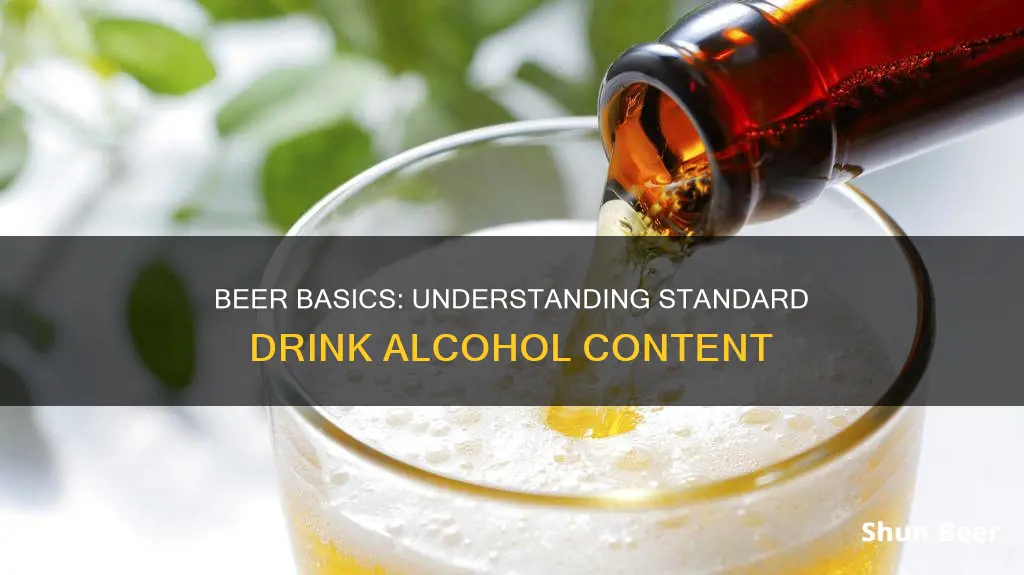
The amount of alcohol in a drink is an important consideration for those who choose to drink, as it can impact your health and well-being. A standard drink is defined as any beverage containing 0.6 fluid ounces or 14 grams of pure alcohol, which is roughly equivalent to 12 ounces of regular beer. However, it's important to note that the percentage of alcohol by volume can vary across different types and brands of beer, so the amount of alcohol in a standard drink can differ. Knowing the alcohol content of your drink is crucial for understanding how it affects your body and for following health guidelines.
| Characteristics | Values |
|---|---|
| Amount of pure alcohol in a standard drink | 14 grams or 0.6 fl oz |
| Amount of pure alcohol in a standard drink in other countries | 8-20 grams |
| Amount of pure alcohol in a standard drink according to the World Health Organization | 10 grams |
| Amount of alcohol in a 12 fl oz regular beer | 5% |
| Amount of alcohol in an 8-10 fl oz malt liquor | 7% |
| Amount of alcohol in a 5 fl oz glass of wine | 12% |
| Amount of alcohol in a 1.5 fl oz shot of liquor | 40% |
What You'll Learn

A standard drink is 12 fl oz of beer
The concept of a standard drink is important because it helps educate people about alcohol consumption and its relative risks to health. It can be tricky to keep track of how much you're drinking, especially when different types of alcoholic drinks contain varying amounts of alcohol. Knowing what counts as one standard drink can help you figure out how much alcohol you're consuming and make informed decisions about your health.
In addition to the amount of alcohol, the way it affects the body will differ from person to person. Factors such as body weight, sex, age, personal metabolic rate, recent food intake, and medications taken can all influence how alcohol is metabolized by the body. As a general rule, the liver can only process small amounts of alcohol, and excessive drinking can lead to serious health issues.
It's worth noting that the serving size of a beverage can be different from the standard drink size. For example, a typical large size of beer in Europe is 500 milliliters (16.9 US fluid ounces) of 5% ABV beer, which is slightly larger than a US pint. Therefore, it's important to be aware of the alcohol content and serving size when consuming alcoholic beverages.
Understanding standard drink sizes can help individuals make informed decisions about their alcohol consumption and ensure they stay within the recommended guidelines for moderate drinking, which is generally defined as one drink per day for women and two drinks per day for men among legal drinking-aged adults.
Beer and Sex: Performance Enhancer or Impairer?
You may want to see also

One standard drink contains roughly 14 grams of pure alcohol
The amount of alcohol in a drink is important to know, as it can affect your health. In the United States, one "standard" drink or alcoholic drink equivalent contains roughly 14 grams of pure alcohol. This is the same as 0.6 fluid ounces. This amount of pure alcohol is found in a 12-ounce can of regular beer, which is usually about 5% alcohol.
It's important to note that the amount of liquid in your glass, can, or bottle does not necessarily reflect the amount of alcohol it contains. Different types of beer, wine, or malt liquor can have varying alcohol content. For example, many light beers have almost as much alcohol as regular beer, about 85%. That's why it's crucial to be aware of the alcohol content in your drink.
The percentage of pure alcohol, or alcohol by volume (alc/vol), can vary within and across beverage types. While standard drink amounts can be helpful for following health guidelines, they may not align with customary serving sizes.
In addition to regular beer, one standard drink of other alcoholic beverages would be:
- 8-10 fl oz of malt liquor or flavored malt beverages (such as hard seltzer)
- 5 fl oz of table wine
- 3-4 fl oz of fortified wine (such as sherry or port)
- 2-3 fl oz of cordial, liqueur, or aperitif
- 1.5 fl oz of brandy or cognac (a single jigger)
- 1.5 fl oz shot of distilled spirits (gin, rum, tequila, vodka, whiskey, etc.)
Excessive alcohol consumption can have serious health impacts, so it is important to monitor your intake and understand what constitutes a standard drink.
Drinking Beer in Public: Where is it Legal?
You may want to see also

Alcohol content varies within and across beverage types
Regular beer typically has an alcohol content of 5%, while some light beers have 4.2%. In the United States, one "standard" drink contains roughly 14 grams of pure alcohol, which is found in 12 ounces of regular beer, which is usually about 5% alcohol. However, the standard drink amount may not reflect customary serving sizes.
Different types of alcoholic drinks have higher concentrations of alcohol, and these can cause drunkenness and alcohol poisoning more quickly and in smaller doses. Beer, the most popular alcoholic beverage worldwide, typically has an alcohol content of between 4% and 6%, although some beers have higher or lower concentrations. "Light beers" have between 2% and 4% ABV, while "malt liquors" have between 6% and 8%.
Wine, another popular and ancient alcoholic beverage, typically has an alcohol content of less than 14% ABV. Champagne, a well-known sparkling wine, has an alcohol concentration of about 10% to 12%. Some wines are “fortified” with distilled alcohol, resulting in a higher alcohol content. For example, Port, Madeira, Marsala, Vermouth, and Sherry are fortified wines with an ABV of around 20%.
Hard cider, which is fermented apple juice, usually has about 5% ABV, while mead, a blend of water and fermented honey, has between 10% and 14% ABV.
Distilled drinks, also known as liquors or spirits, have a higher alcohol content than fermented drinks like beer and wine. The distillation process concentrates the alcohol, increasing the alcohol content. Gin, for instance, typically has an ABV of 35% to 55%, while brandy, which is distilled wine, ranges from 35% to 60% ABV. Whiskey, another spirit made from fermented grain, has an ABV range of 40% to 50%.
The ABV of alcoholic beverages can vary significantly, and it's important to understand these variations to make informed choices about alcohol consumption.
Enjoying Beer After Secondary Fermentation: Is It Worth It?
You may want to see also

A standard drink is defined differently in different countries
The amount of alcohol in a standard drink of beer varies from country to country. While a standard drink generally refers to a fixed amount of pure alcohol, the amount of alcohol that constitutes a standard drink differs across nations.
In the United States, a standard drink contains 0.6 fluid ounces or 14 grams of pure alcohol. This is equivalent to 12 ounces of regular beer, which is typically around 5% alcohol.
In the United Kingdom, a unit of alcohol, which is comparable to a standard drink, is often misleadingly stated as one unit per half-pint of beer. However, this approximation does not consider the varying strengths and volumes of different beers. To accurately calculate the amount of pure alcohol in a drink, one can use the formula:
> Pure alcohol mass = volume x alcohol by volume x density of alcohol
For example, a 350 ml glass of beer with an ABV of 5.5% contains approximately 15.20 grams of pure alcohol.
In Australia, a standard drink of beer is defined differently. A 375 ml can of full-strength beer, typically containing 4.8% alcohol, equates to 1.4 Australian standard drinks.
The World Health Organization's Alcohol Use Disorders Identification Test (AUDIT) uses 10 grams of pure alcohol as a standard drink in its questionnaire, and this definition has been adopted by more countries than any other amount. However, the values for a standard drink across the globe range from 8 to 20 grams, with some countries basing their definition on mass (grams) and others on volume (milliliters or other units).
The variation in standard drink definitions highlights the need for awareness when consuming alcohol, as the amount of alcohol in a beverage can significantly impact health and intoxication levels.
Beer and Penicillin: Safe Mix?
You may want to see also

Alcohol affects each person differently
The amount of alcohol in a standard drink of beer varies depending on the type of beer. In the US, a standard drink is defined as 0.6 US fluid ounces (18 ml) of ethanol per serving, which is about 14 grams of alcohol. This corresponds to a 12-US-fluid-ounce (350 ml) can of 5% beer. However, it's important to note that the definition of a standard drink varies across different countries.
Now, let's discuss how alcohol affects each person differently:
Body Size and Composition: The size and weight of an individual play a crucial role in how alcohol affects them. Generally, smaller individuals with lower body weight tend to be more sensitive to the effects of alcohol. This is because a bigger person's drug distribution becomes diluted, resulting in less pronounced effects.
Food Intake: The amount of food in your system can also influence how alcohol affects you. Alcohol is absorbed into the bloodstream, and this absorption process slows down when you have a full meal in your system. Therefore, drinking on an empty stomach will lead to faster absorption and more pronounced effects.
Metabolism: Each person's metabolism is unique, and it plays a role in breaking down alcohol. People with higher metabolisms are known for their ability to process substances quickly, including alcohol. A faster metabolism can lead to a reduced impact of alcohol and quicker elimination from the body.
Liver Function: The liver is responsible for breaking down alcohol through a complex process. However, the liver has a limited amount of glutathione, an antioxidant necessary for this process. If the liver is overwhelmed or its function is impaired, it may not effectively metabolize alcohol, leading to a buildup of toxic byproducts and more severe effects.
Age: Age also plays a factor in how alcohol affects an individual. Older people tend to have a lower tolerance for alcohol due to a decreased ability to metabolize it. Additionally, alcohol can have more detrimental effects on older individuals, including compromising their ability to perform simple tasks, altering vision and hearing, impairing judgment, and delaying reaction time.
Co-Occurring Health Conditions: Alcohol can aggravate existing health conditions, especially in older adults. For example, it can worsen heart problems, stomach ulcers, and mental health disorders. It can also interact negatively with certain medications, posing serious health risks.
Psychological Factors: Alcohol consumption is often linked to psychological factors, such as anxiety, depression, and stress. People may turn to alcohol to self-medicate or manage their mental health. However, alcohol can also contribute to psychological disturbances and mood swings.
Tolerance and Dependence: With repeated alcohol consumption, individuals can develop tolerance, requiring them to drink more to achieve the same effects. This can lead to a dangerous cycle of escalation and an increased risk of developing an addiction or substance use disorder.
Genetics and Life Experiences: Finally, a person's response to alcohol is influenced by a combination of their genetic makeup and life experiences. While there is no single gene that determines alcohol sensitivity, the interplay between genetic factors and environmental influences shapes how alcohol affects each individual.
In summary, while the standard drink of beer contains a defined amount of alcohol, it's important to recognize that alcohol affects each person uniquely due to a variety of biological, psychological, and genetic factors. These factors contribute to variations in absorption, metabolism, and overall sensitivity to the effects of alcohol. Understanding these differences is crucial for making informed decisions about alcohol consumption and promoting safe and responsible drinking practices.
Sun-Soaked Beer: Safe to Drink or Not?
You may want to see also
Frequently asked questions
A standard drink of beer in the US contains 0.6 fluid ounces or 14 grams of pure alcohol. This is the equivalent of 12 fluid ounces of regular beer.
A standard drink is a measure of alcohol consumption representing a fixed amount of pure alcohol. The amount of pure alcohol in a standard drink varies from country to country.
A standard drink of wine in the US is defined as 5 fluid ounces of table wine or 4 fluid ounces of fortified wine.
A standard drink of distilled spirits in the US is defined as 1.5 fluid ounces of 80-proof liquor.
Standard drink sizes help people understand how much alcohol they are consuming and track their drinks. This is important as excessive drinking can lead to serious health issues.







